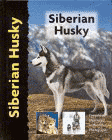
Siberian Husky (Pet Love)
Siberian Huskies are striking looking dogs which can have surprisingly light eyes, which may be blue, amber, brown, or a mix, or they may even have eyes of different colours. They are very similar to Alaskan Malamutes, in that they are sled dogs with generally friendly natures that like to run, dig and eat, and can withstand extreme cold due to their very thick fur. Like Malamutes, they are also clean dogs that deposit large amounts of fur in your home when they shed their undercoats every spring, and, to a lesser extent in autumn. Sibes aren't as big as Alaskan Malamutes, and are generally much easier to handle. They are still dogs that present challenges for novices, such as the usual spitz independence.
Training in house rules should start as soon as your pup arrives, since Sibes will tend to get away with whatever you let them, and it stores up trouble to be indulgent with them as pups. They need strong leadership without bullying. This involves not allowing them access to resources if they are being pushy, for example, not letting them out of the door until they sit nicely. Shouting tends not to be an effective way of persuading them to behave the way you want. They also have a strong tendency to chase cats and other small animals, which socialization may not eradicate. A Sibe may tolerate a cat in your home that he has known since he was a puppy, but is still likely to chase all other cats. Siberian Huskies are well known for their talent for jumping over and digging under fences, and a desire to wander. They need good fences so they don't wander round the neighbourhood terrorising the local cats. Sibes are better hiking companions than Alaskan Malamutes, because they are smaller, so less likely to pull you over. They do need to get out and about. Bored Siberian Huskies left alone a lot will tend to dig holes in your sofa and otherwise destroy your home. They will also tend to raid food stores if these are accessible. The best activity for Siberian Huskies is the activity they were designed to do, sledding, and they are popular among people who like sled dog racing, since they are faster than Malamutes. Siberian Huskies have a lot of stamina, and work well in cold weather, though they should not be exercised in the heat of the day in summer. They need to mature properly before they can learn to be sled dogs, however, because their bone development can be affected if they start working too young.
Are they good with children? They were bred to be raised as family dogs, as well as to work as sled dogs, and they generally enjoy the company of children. This tolerance should not be taken for granted, and Sibe pups need to be socialized with children, while very small humans should be supervised with Sibes. These dogs also generally get on well with other dogs, but can get involved in fights, especially if you have more than one dog in your home. They are very much pack dogs, and will try to settle uncertainties about rank by fighting.
Working sled dogs are usually kept in kennels, but dogs kept mainly as pets are likely to be bored if left outside and not worked much, especially if they are left alone, with no other dogs for company. Keeping sled dogs indoors does involve risk, since they can be destructive, and whether they are indoors or outside, they need to work.
Are they barky dogs? Sort of. Siberian Huskies can be quite noisy without actually barking, and have a very wide vocal range which allows them to communicate very effectively with other dogs and their owners. They can also howl, especially if you have more than one Sibe, when they can perform choruses. They are not very good guard dogs because they are so friendly, but this means that you are much less likely to have your Sibe attack a child who wanders into your garden, than if an Akita or Chow Chow were guarding the garden.
Siberian Huskies need less food than Alaskan Malamutes, though most would quite happily eat as much. They do have a tendency to put on weight when they are not working. There are special performance foods for working dogs, and it's also worth studying the nutritional needs of working dogs, so you know how much more food to give a working Sibe, and what proportions of nutrients a working dog needs. Common health problems include hip dysplasia, eye trouble, and skin problems.
This book is a good introductory guide to the breed, which gives a clear picture of Siberian Huskies' origins, character and needs, in a way that is easy for novice owners to follow.



